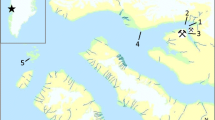Abstract
The present study evaluates the use of an individual-specific transgenerational barium dual-isotope procedure and its application to salmon specimens from the Sella River (Asturias, Spain). For such a purpose, the use of laser ablation inductively coupled plasma mass spectrometry (LA-ICP-MS) in combination with multiple linear regression for the determination of the isotopic mark in the otoliths of the specimens is presented. In this sense, a solution in which two barium-enriched isotopes (137Ba and 135Ba) were mixed at a molar ratio of ca. 1:3 (N Ba137/N Ba135) was administered to eight returning females caught during the spawning period. After injection, these females, as well as their offspring, were reared in a governmental hatchery located in the council of Cangas de Onís (Asturias, Spain). For comparison purposes, as well as for a time-monitoring control, egg and larva data obtained by solution analysis ICP-MS are also given. Otoliths (9-month-old juveniles) of marked offspring were analysed by LA-ICP-MS demonstrating a 100 % marking efficacy of this methodology. The capabilities of the molar fraction approach for 2D imaging of fish otoliths are also addressed.







Similar content being viewed by others
References
Almany GR, Berumen ML, Thorrold SR, Planes S, Jones GP (2007) Science 316:742–744
Munro AR, Gillanders BM, Elsdon TS, Crook DA, Sanger AC (2008) Can J Fish Aquat Sci 65:276–285
Woodcock SH, Gillanders BM, Munro AR, McGovern F, Crook DA, Sanger AC (2011) Ecol Fresh Fish 20:157–165
Nielsen LA (1992) Methods of marking fish and shellfish. Am Fish Soc Spec Publ 23. Bethesda, Maryland
Brooks RC, Heidinger RC, Kohler CC (1994) North Am J Fish Manag 14:143–150
Schroeder SL, Knudsen CM, Volk EC (1995) Can J Fish Aquat Sci 52:1141–1149
Thorrold SR, Jones GP, Planes S, Hare JA (2006) Can J Fish Aquat Sci 63:1193–1197
Williamson DH, Jones GP, Thorrold SR (2009) Mar Biol 156:2517–2525
Huelga-Suarez G, Moldovan M, Garcia-Valiente A, Garcia-Vazquez E, Garcia Alonso JI (2011) Anal Chem 84:127–133
Campana SE, Neilson JD (1985) Can J Fish Aquat Sci 42:1014–1032
Martin J, Bareille G, Berail S, Daverat F, Pécheyran C, Bru N, Tabouret H, Donard O (2012) J Fish Biol (submitted)
Berglund M, Wieser ME (2011) Pure Appl Chem 83:397–410
Rodríguez-Castrillón JA, Moldovan M, Ruiz Encinar J, García Alonso JI (2008) J Anal At Spectrom 23:318–324
Williamson DH, Jones GP, Thorrold SR, Frisch AJ (2009) J Fish Biol 74:891–905
IPCS (2012) Barium and barium compounds. Concise International Chemical Assessment Document (CICAD) 33, 2001 [Online]. http://www.inchem.org/documents/cicads/cicads/cicad33.htm#6.2 Accessed 8 Oct 2012
ATSDR (2005) Toxicological profile for barium compounds. Atlanta, GA: U.S. Department of Health and Human Services. Public Health Service, Agency for Toxic Substances and Disease Registry
Prichard E, Barwick V (2007) Quality assurance in analytical chemistry. Wiley, Chichester
Acknowledgments
The authors would like to thank Jerónimo de la Hoz and the Dirección General de Recursos Naturales y Protección Ambiental (Gobierno del Principado de Asturias) for their collaboration and care of the marked salmons. Dr. America Garcia-Valiente is acknowledged for the extraction of fish otoliths and Emilio J. Ariño and Joaquín Vázquez for their help with the otolith sample preparation. Financial support through the project MICINN CTQ2009-12814, as well as the provision of FEDER funds for the purchase of the multi-collector ICP-MS instrument, is gratefully acknowledged.
Author information
Authors and Affiliations
Corresponding author
Additional information
Published in the topical collection Isotope Ratio Measurements: New Developments and Applications with guest editors Klaus G. Heumann and Torsten C. Schmidt.
Rights and permissions
About this article
Cite this article
Huelga-Suarez, G., Fernández, B., Moldovan, M. et al. Detection of transgenerational barium dual-isotope marks in salmon otoliths by means of LA-ICP-MS. Anal Bioanal Chem 405, 2901–2909 (2013). https://doi.org/10.1007/s00216-012-6452-2
Received:
Revised:
Accepted:
Published:
Issue Date:
DOI: https://doi.org/10.1007/s00216-012-6452-2




